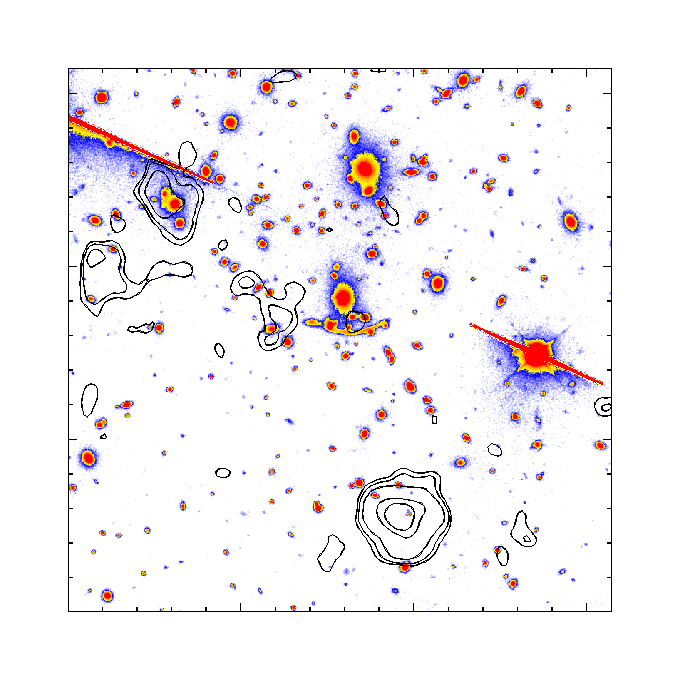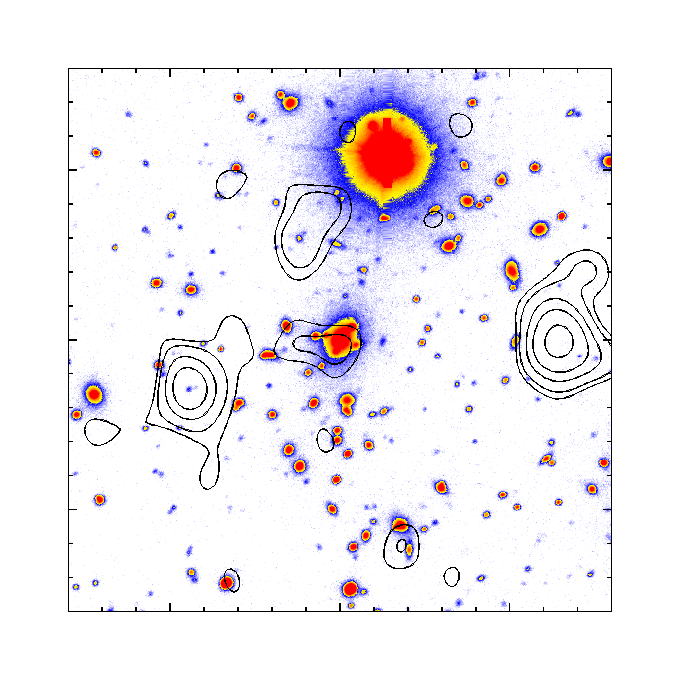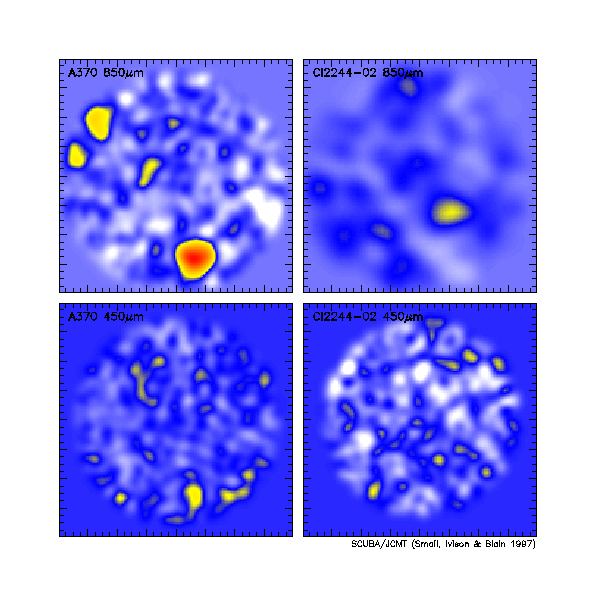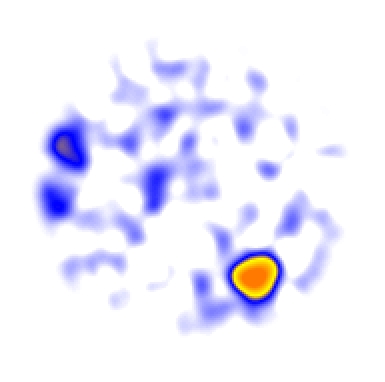

Overlays of the 850um SCUBA maps onto deep CFHT/P200 I images of two clusters: Abell 370 (z=0.37) and Abell 1835 (z=0.25). The fields of view are 160 arcsec square and the submm maps show a number of significant sources in both maps. The brightest source in the A370 map has been identified as a z=2.80 starburst/agn, while one of the two bright sources in A1835 has recently been identified as a z=2.53 starburst on the basis of Keck spectroscopy undertaken by Amy Barger and Len Cowie at the University of Hawaii.


The sub-mm maps below show a number of galaxies detected at wavelengths around 850um. These objects are seen in the sub-mm because the dust within them is reprocessing UV and optical star-light and emitting large quantities of radiation in the sub-mm. Only one of these 850um sources (the brightest in the image at the upper-left, called SMM 02399-0136 or `Le Blob' for short) is seen in the image taken at wavelengths around 450um and the constraints this provides on the redshifts of the sources indicates that the majority of these objects are likely to lie at z>>1 (this is equivalent to saying we are seeing them at a time when the Universe was half its present age). If this is the case then these represent very luminous and strongly star-forming galaxies (`proto-galaxies'?). Optical surveys of the distant Universe with Hubble Space Telescope have failed to uncover this population, probably due to the high optical obscuration caused by the dust. The high surface density of the sub-mm sources indicates that the population being missed by the optical surveys could account for over half the star-formation in the distant Universe. The paper detailing these observations will appear in the November 15th edition of The Astrophysical Journal Letters (1997, 490, L5-L8) and is also available as postscript from here. A paper discussing the details properties of Le Blob has been submitted to the Monthly Notices of the Royal Astronomical Society, a preprint is available here.

CAPTION:These are SCUBA maps of two distant cluster lenses, one called A370 (top/bottom on the left) the other Cl2244-02 (on the right), and taken at two different wavelengths: 450um and 850um. There are 4 sources visible in the 850um map of A370, and the brightest of these (at the bottom of the image) has been named `Le Blob'. A spectrum of this galaxy taken with the 3.6-m Canada France Hawaii Telescope by Dr Jean-Paul Kneib and Dr Jean-Francois Le Borgne of Toulouse Observatory shows that it lies at a redshift of z=2.8, or roughly two-thirds of the way back to the Big Bang. This may well be a young galaxy caught in the act of formation. All the maps are roughly 180 arcsec in diameter - or about 1/10th the diameter of the full moon - and the major tick marks show 10 arcsec.
Text of the article in The Times on 19/11/97 is here. A more detailed piece by Damian Carrington was in The Scotsman on 20/10/97. Use of the images above or below should attribute the Royal Observatory, Edinburgh.


CAPTION:These two images show different views of the same region of sky containing the gravitational cluster-lens Abell 370. On the left we have a true colour `optical' image made up of blue, red and near-infrared images taken with the 3.6-m Canada France Hawaii Telescope by Dr Jean-Paul Kneib of Toulouse Observatory. The optical image shows a giant gravitational arc seen through the centre of the cluster of galaxies, this is a image of a background galaxy distorted and magnified by the foreground cluster lens. A number of other distorted images of visible across the frame - as well as many of the galaxies actually within the cluster which appear yellow. There are obviously are a large number of very faint galaxies visible in this image, but it is impossible to tell which are the distant, young galaxies which are crucial for studying galaxy formation and evolution. However, on the right is the submillimetre SCUBA map of the same field, although this detects only a few objects these are all likely to be the dusty, young galaxies which are need to test models of galaxy formation. Thus SCUBA's submillimetre observations are critical for understanding the evolution of galaxies.



Last Modified: July 11th, 1998. [Netscape 2.0]